
Worldcarblog.com
World premiere: Electric Mercedes EQE SUV
The Mercedes EQE SUV is a versatile alternative to the EQE business sedan.
Like the Mercedes EQE sedan, the new electric SUV is available with the basic innovations of the EQS model and at the same time is more dynamic than the EQS SUV model.
Mercedes says that the EQE SUV is one of the most spacious representatives of its class. Still, with a 3,030 mm wheelbase that's nine centimeters shorter than the sedan, it's more compact than the EQE sedan.
As the fourth model, following the EQS and EQE sedans, as well as the EQS SUV, the EQE SUV uses a new mechanical platform designed for three-pointed star electric vehicles.
The modular drive concept enables the EQE SUV to offer a wide range of maximum total power outputs from 215 to 300 kW. Depending on the equipment and configuration of the vehicle, the European variants of the vehicle can have a WLTP autonomy of up to 590 kilometers.
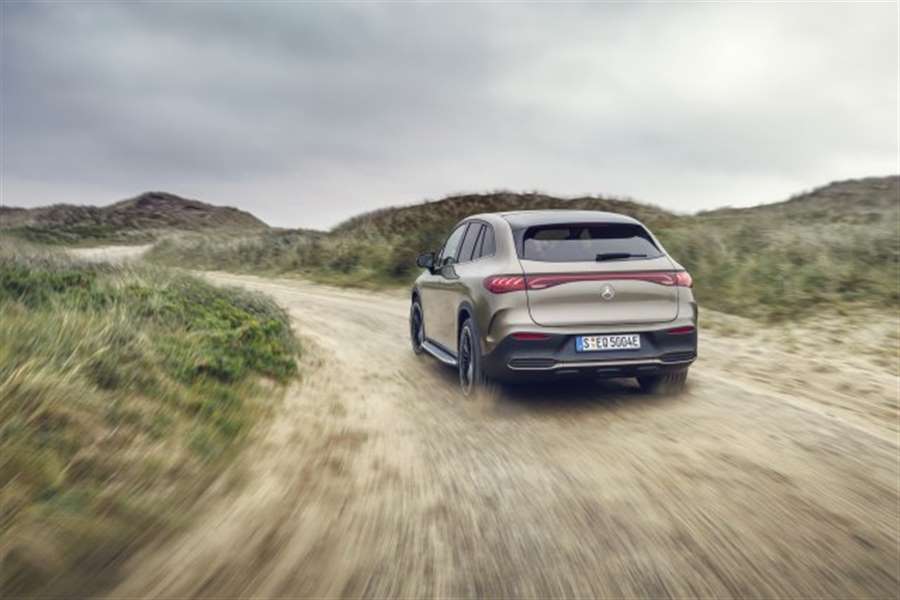
In the EQE SUV, the lithium-ion battery consists of ten modules. In certain cases, the company's innovative battery management software can be updated over-the-air (OTA).
The current generation of driving assistance systems includes a number of functions that support the driver.
General standard equipment on the EQE SUV includes ATTENTION ASSIST, Active Brake Assist, Active Lane Keeping Assist, Parking Package with reversing camera and Speed Limit Assist. System status and activity are shown full-screen on the driver assistance display.
Additional options are available in the Assistance package, as well as in the Driving Assistance Plus package.
The mechanical basis of the new EQE SUV consists of a four-link suspension at the front and a multi-link independent suspension at the rear.
Due to the relatively short wheelbase of 3,030 millimeters and the appropriate suspension settings, Mercedes claims that the car is particularly nimble and manageable even with the basic setup.
AIRMATIC air suspension with ADS+ continuously adjustable damping is available as an optional extra. To increase the ground clearance, the vehicle level can be raised by up to 30 millimeters.
In addition to the DINAMIC SELECT programs ECO, COMFORT, SPORT and INDIVIDUAL, EQE SUV models with the 4MATIC all-wheel drive system also have an OFFROAD program for off-road driving.
A rear axle steering system with a maximum steering angle of 10 degrees is available as an option.
MBUX Hyperscreen on demand
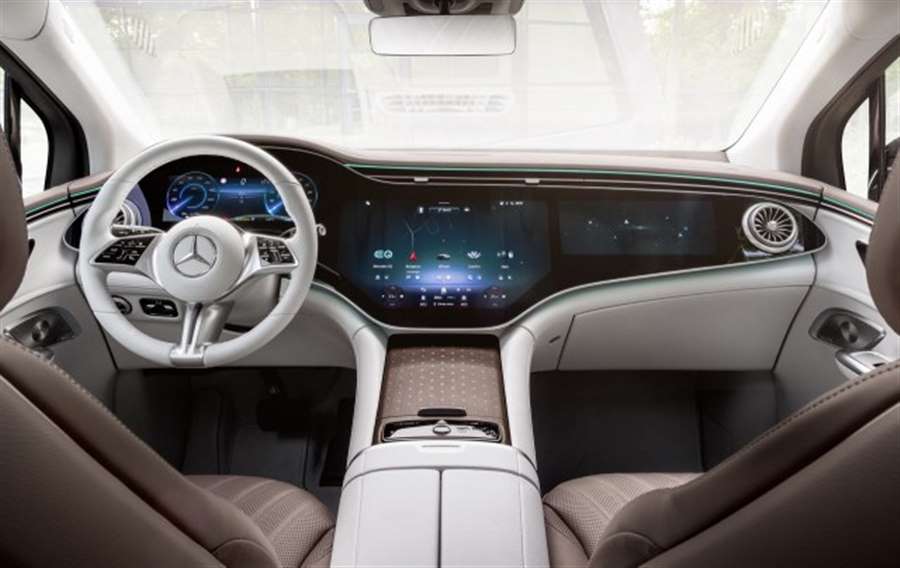
With customizable software, the MBUX display and operating system make personalized suggestions for numerous infotainment, comfort and vehicle functions. The highlight of the interior is the optional MBUX Hyperscreen.
With the MBUX Hyperscreen, the three displays merge almost seamlessly to create a screen range over 141 centimeters wide.
The front passenger in the EQE SUV has the option of a 12.3-inch OLED display with its own user interface.
The system uses intelligent camera-based blocking logic that recognizes whether the driver is looking towards the passenger display. If this is the case, the system automatically dims the dynamic content for security reasons.
Smart route planning
When it comes to navigation with "electric intelligence", the name says it all. Because based on numerous factors, it plans the fastest and most convenient route including charging stations.
It also reacts dynamically to traffic jams or a change in driving style, for example.
Navigation with electric intelligence is smart; calculates estimated charging costs per charging stop. In addition, the user can individually edit the planned routes.
Planned routes can be individually edited by adding desired charging stations along the route or excluding suggested charging stations.
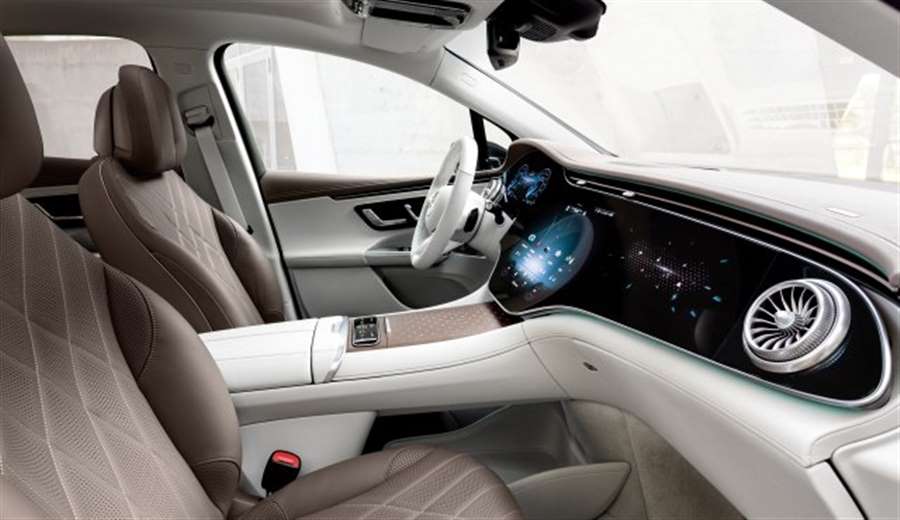
Heat pump as standard
The Mercedes EQE SUV has a sophisticated thermal architecture with a heat pump as standard. This makes the system work very efficiently: excess heat from the electric drive (inverter and electric motor) as well as high-voltage batteries that would otherwise be released into the environment can be used to heat the interior.
This drastically reduces battery consumption for the heating system, thus increasing the range.
Another useful and efficient function is air conditioning control before departure. The THERMATIC automatic climate control system with two climate zones is standard in the vehicle, while THERMOTRONIC with four zones is available as an option.
Adjusted charging tariffs
From June 2022, Mercedes me Charge offers three new charging tariffs in Europe that are tailored to individual driving performance.
"Mercedes me Charge S" for occasional charging, "Mercedes me Charge M" for normal charging and "Mercedes me Charge L" for frequent charging.
With the introduction of a new, transparent tariff system, fixed prices that are valid regardless of the operator are partially available to customers. With the Plug & Charge function, the EQE SUV can also be easily charged.
Lots of high-tech features
The DIGITAL LIGHT headlight technology (special equipment) enables innovative functions, such as the projection of auxiliary markings or warning symbols onto the road.
Another highlight of the equipment is the ENERGIZING AIR CONTROL Plus. The HEPA (High Efficiency Particulate Air) filter cleans the incoming outdoor air at a very high level of filtration. ENERGIZING COMFORT connects the various comfort systems in the vehicle.
Individual ENERGIZING COMFORT programs allow a special program for good mood depending on the mood or needs of the user. This improves physical comfort and performance while driving and during breaks.
The Dolby Atmos sound format raises the audio experience in the EQE SUV to a new level, according to Mercedes.
The proportions of the EQE SUV combine function and aesthetics with the sporty character of an SUV.
Wheels in sizes from 19 to 22 inches are mounted flush with the outer edge of the body.
The EQE SUV shares some aerodynamic measures with models from the same family. The chassis with numerous aerodynamic details plays a central role in the very good drag value Cd of 0.25, which is achieved despite the large cargo volume and short rear overhang.
But the dimensional concept with the flat windshield, broad roofline and recesses were also important factors.
High level of passive safety
The principles of Integral Safety apply regardless of the type of drive system. Like all other Mercedes Benz models, the EQE SUV therefore has a rigid passenger compartment, special deformation zones and state-of-the-art restraint systems.
The European version of the EQE SUV can detect whether the rear seats are actually occupied. If the passenger in the back is not wearing a seat belt, the driver receives a special warning. The so-called passenger presence reminder can indicate children in the back of the vehicle.
In vehicles for Europe, Australia, New Zealand, USA and Canada, this system is fitted as standard.
Motorization
Mercedes will initially offer three versions of the EQE SUV.
The basic EQE 350+ with rear-wheel drive and a single electric motor of 292 HP (215 kW) develops 565 Nm of reverse torque.
It is followed by the EQE 350 4Matic with 4-wheel drive and two electric motors. It is interesting that the total power is the same as in the rear-wheel drive model (292 hp), but the maximum torque is higher thanks to the additional electric motor and is 765 Nm.
At the top of the range is the EQE 500 4Matic, also with all-wheel drive and two electric motors. The total power of this version is 408 hp (300 kW) and the torque is 858 Nm.
CO2-neutral production as part of eco-balance
Production of the EQE SUV will begin in December at the Mercedes-Benz plant in Tuscaloosa, Alabama (USA).
A battery plant in nearby Bibb County supplies batteries for this model as well as the EQS SUV.
As of this year, all Mercedes-Benz passenger car and van plants worldwide have achieved CO2 neutral production as part of their environmental balance – including the two Mercedes plants in Alabama.
The hurricane in the USA turned electric cars into time bombs
Hurricane Ian created numerous problems in Florida, and firefighters in this American state became aware of the danger posed by submerged electric cars.
Numerous electric vehicles were under water during the hurricane, and the batteries that were soaked could soon catch fire, so the owners of such cars were warned of the danger of fire.
Jimmy Patronis, Florida's chief financial officer and state fire marshal, posted the warning on Twitter, noting that the first cases had occurred, some of which he had personally witnessed. He also posted a video of when firefighters tried to put out a fire on a Tesla Model X that caught fire in the middle of the street. One of the onlookers said that they poured more than 5,500 liters of water on the Tesla, but the car was still smoking.
Extinguishing a battery fire requires special training and understanding of electric vehicles, and a fire can last several days even with the intervention of firefighters. According to a recent study by AutoInsuranceEZ, hybrid vehicles are actually more susceptible to fires than electric vehicles, but the bigger problem is that the fire itself is extremely difficult to put out. Due to corrosion in the cells of the lithium-ion battery, the electric car can emit smoke and flames for a long time, even after being submerged in water.
As Index.hr writes, considering that Florida has the second largest number of electric vehicles in the USA (behind California), Florida is becoming aware of this problem. At the end of last year, around 100,000 electric vehicles were registered in this federal state.
Ford F-150 arrives in Europe
Hedin US Motor AB, a branch of the Hedin Mobility Group, will import the F-150 pickup truck into Europe with the blessing of Ford Motor Company.
"The Ford F-150 is the world's best-selling pickup truck for a reason, so we're thrilled to expand our group's import sector by bringing the American icon to Europe," said the company's founder and No. 1 man, Anders Hedin. "We look forward to offering European dealerships the F-150 family of vehicles, complete with a full service program, warranties, spare parts and accessories," added Anders Larkvist, CEO of Hedin US Motor AB.
Sales are scheduled to begin in November 2022. Pricing information is currently unavailable, but what we do know is that other European markets will follow the lead of Germany and Sweden, where buyers are presented with three options, starting with the Coyote V8-powered Lariat. The PowerBoost hybrid Limited and EcoBoost Raptor are also on their way to the Old Continent.
What may be a bit surprising is that there is no electric Lightning among the selections, but on the other hand it is also understandable, since Ford can hardly cope with the demand on domestic soil. The importer doesn't mention what cabin configurations are in the game, although we do know that the Raptor comes in a SuperCrew variant.
The Lariat is available in the US in SuperCab and SuperCrew trims, while the Limited can be configured as a SuperCrew. The logical conclusion would be that Hedin ordered SuperCrew models throughout the range.
As for pricing, the net price for the four-door Lariat with the 5.0-liter Coyote V8 engine is $54,545. The Limited powered by the PowerBoost hybrid system costs $81,465, while the Raptor costs $72,520.
Electrification or retirement: What awaits the Porsche 911?
The most famous model of the company from Stuttgart has been produced without interruption since 1964, and the imminent electrification of the automotive industry makes us wonder what the future holds for the 911.
It will not be difficult to electrify the Cayenne, Macan, and Panamera models one day, but the big question is what Porsche is planning with the 911 model.
Recently, spy shots of the redesigned version of the Porsche 911 have been appearing more and more frequently on the Internet.
All versions, coupe, convertible, even the Turbo version, were seen during the final tests. The Safari version was also recorded, and it is a raised version with off-road reinforcements and 4×4 drive, primarily intended for off-road enjoyment.
What has only been unofficially announced is that the cockpit will also undergo significant changes. Of course, the arrangement will go in the further process of digitization.
Until now, the instruments have had an attractive analog tachometer surrounded by screens simulating analog pointers, of course with the option of choosing to display a variety of information. The instruments are expected to be fully digitized.
There are no announcements regarding the engine, and minor changes are expected there, perhaps in a slight recalibration and a minor increase in power and torque. What is expected is that, through the redesign, Porsche's experts will somehow pack a hybrid drive into the existing platform. Well, that's already news. Moreover, it will not be a hybrid just for the sake of speed, but the hybrid 911 will be more powerful than the Turbo version. Similar to the Panamera model.
All this makes one think - what is Porsche planning with the 911 model? With the Cayenne models, the Macan will be easy. At some point, it probably won't be difficult to explain to customers that the Cayenne is now an all-electric model. The same applies to the Macan model, and it won't be difficult to convert the Panamera to electricity either, as long as it is conceptually separated from the Taycan in the model range.
And what to do with the legend? What fate awaits the 911 and when and how can this model become electric?
EuroNCAP: Five stars for the Mazda CX-60
The Japanese SUV scored 91% in the child passenger category, and 88% in the adult passenger category.
The all-new model, the Mazda CX-60, received the maximum five-star rating from EuroNCAP in the latest series of tests conducted by the organization. The Japanese SUV scored 91% in the child passenger category, and 88% in the adult passenger category.
An impressive result of 89% was also achieved in the category for unprotected road users (pedestrians, cyclists...).
European manufacturers are not sleeping peacefully: Every fifth electric car already comes from China
The Mazda CX-60 achieved the maximum number of points in the 6- and 10-year-old category for performance in the crash test, both for frontal and side collisions.
In tests for child passengers, the correct installation of child seats also received high marks, leading to an excellent combined score of 91%.
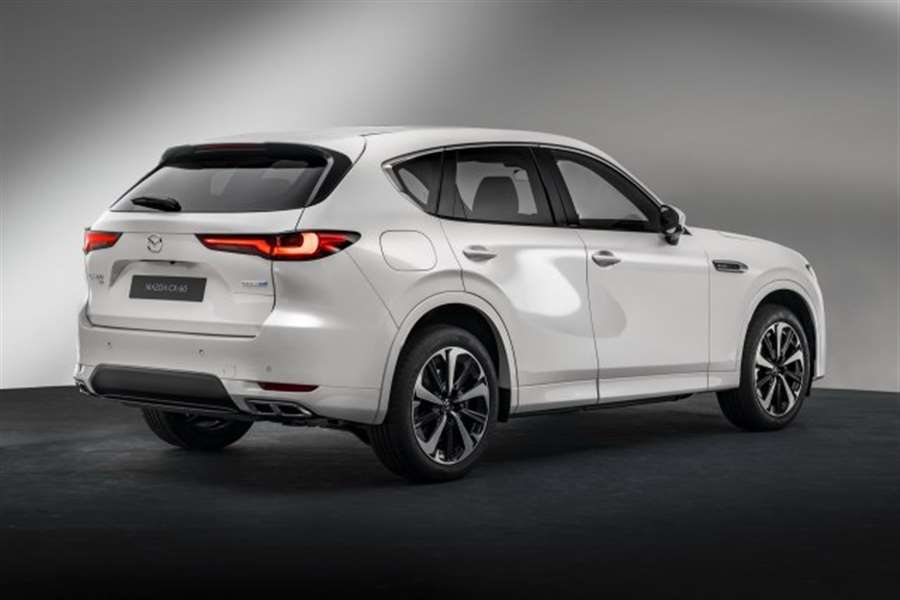
With high scores in side crash tests and a good level of protection recognized in the full-width rigid barrier test, it also achieved a significant score of 88% in adult occupants.
In both the side barrier and the – more severe – side pillar impact, the protection of all critical body parts was good, leading to the maximum score in this segment of the assessment.
The Mazda CX-60 scored an impressive 89% in the category of vulnerable road users. The adequate performance of the intelligent automatic braking system (AEB) made the result one of the best so far for all tested vehicles since the last EuroNCAP ratings.
The all-new large SUV joins the likes of the Mazda CX-5 (2017), Mazda 6 (2018), Mazda 3 and Mazda CX-30 (both 2019), as well as the Mazda MX-30 (2020) in getting the maximum five star in the EuroNCAP test.
The Mazda CX-60 achieved an impressive result in the fourth category of the EuroNCAP test: safety systems, where it recorded a score of 76%.
The five-star rating is contributed by the adaptable Skyactiv architecture on which the CX-60 is based (Skyactiv Multi-Solution Scalable Architecture).
The wide range of the company's advanced i-Activsense driver support safety technologies that the vehicle is equipped with play another key role in achieving this rating.
New technologies, including Turn Across Traffic Assist, SBS-R pedestrian detection and BSM Vehicle Exit Warning, which detects vehicles, pedestrians and cyclists approaching from the rear of the vehicle (BSM Vehicle Exit Warning), they help drivers recognize potential risks and reduce the likelihood of damage or injury, while offering high standards of pedestrian protection.
In addition, Mazda's Kinematic Posture Control (KPC) system additionally stabilizes the vehicle while in motion, facilitating safe driving, and these functions further reduce the possibility of an accident, the Japanese manufacturer explains.
Tested: Lexus NX350h Luxury AWD Is an Old-School Hybrid
As a traditional-style hybrid, this compact luxury SUV is less expensive than a plug-in but also less desirable.
Although hybrids are proliferating in the compact luxury SUV space, the 2022 Lexus NX350h is in a class of its own. Whereas those other compact luxury SUVs, including the range-topping Lexus NX450h+, are plug-ins (or PHEVs), the NX350h is a traditional-style hybrid.
Compared to a PHEV, the NX350h's much smaller, lithium-ion battery pack has only enough energy to power the SUV short distances on electricity alone, whereas its plug-in peers are all capable of traveling more than 20 miles on battery power. The old-school NX350h still delivers impressive fuel economy, though, and its more basic powertrain also keeps costs down, allowing the $42,700 gasoline-electric Lexus to take the title of most affordable hybrid in its segment.
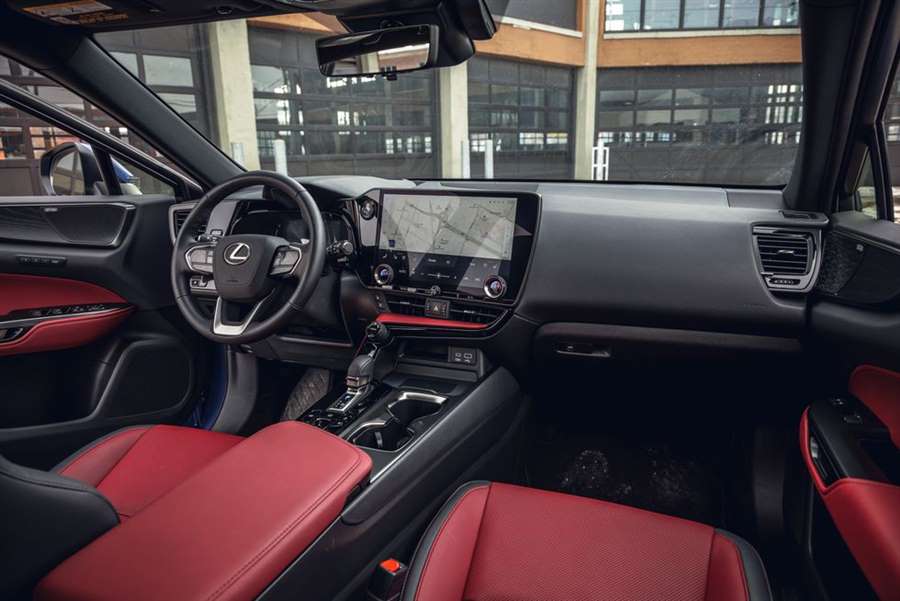
The Price You Pay
That said, going heavy on the options can quickly cut into the cost-effectiveness of the NX350h, with our Nori Green Pearl test vehicle wearing $13,630 in options. The priciest was the $7450 Luxury package, which added heated and ventilated front seats, a power-adjustable steering column, ambient interior lighting, a 10.0-inch head-up display, and a massive 14.0-inch infotainment screen with in-dash navigation in place of the standard 9.8-inch display.
HIGHS: Least-expensive hybrid in its segment, comfortable ride, quality interior.
While both infotainment options feature physical knobs for adjusting the temperature of the dual-zone automatic climate-control system and the audio volume, neither includes a physical control for audio tuning or a dedicated homepage, the lack of which makes navigating through the system's menus an unnerving experience. As Steve Krug writes in his book Don't Make Me Think, a homepage is like "a North Star," providing a comparatively "fixed place" to return to in a digital environment that otherwise requires users to remember where they are in the setup's "conceptual hierarchy [to] retrace [their] steps."
Though it vastly improves upon the maddening touchpad interface of the outgoing model, the latest NX's touchscreen system is not without its flaws. This sentiment also applies to the NX350h's powertrain.
Driving Dynamics
The all-wheel-drive NX350h packs an additional 45 horses compared to its predecessor, extracting a total of 239 horsepower from its 2.5-liter four-cylinder engine and trio of electric motors. (There are two up front—one of which connects to a planetary gearset to mete out the combustion engine's power in a manner that mimics a belt-driven continuously variable automatic transmission—and one mounted at the rear axle.) Factor in a curb weight of 4062 pounds, 151 fewer pounds than the last NX300h we tested, and it's little surprise the 2022 NX hybrid is also a good deal quicker.
Accelerating to 60 mph is a 7.6-second affair, while the run from 50 to 70 mph happens in 5.0 seconds, figures that cut 0.5 and 0.6 second from those of the aforementioned NX300h. Granted, it can't keep up with the 275-hp NX350 or the 302-hp NX450h+. (The turbo four-cylinder NX350 hits the mile-a-minute mark in 6.6 seconds and accelerates from 50 to 70 mph in 4.5; for the NX450h+ F Sport, those times are 5.6 and 3.8 seconds, respectively.) Still, the NX hybrid is less of the slowpoke it once was and now packs acceptable punch for merging onto freeways and passing at highway speeds.
Use all of that performance, however, and the NX350h lets more of the four-cylinder engine's grating grumble enter the cabin. The 75 decibels we recorded under flat-foot acceleration exceeded both that of the NX300h and the Toyota Corolla Hybrid by 1 decibel.
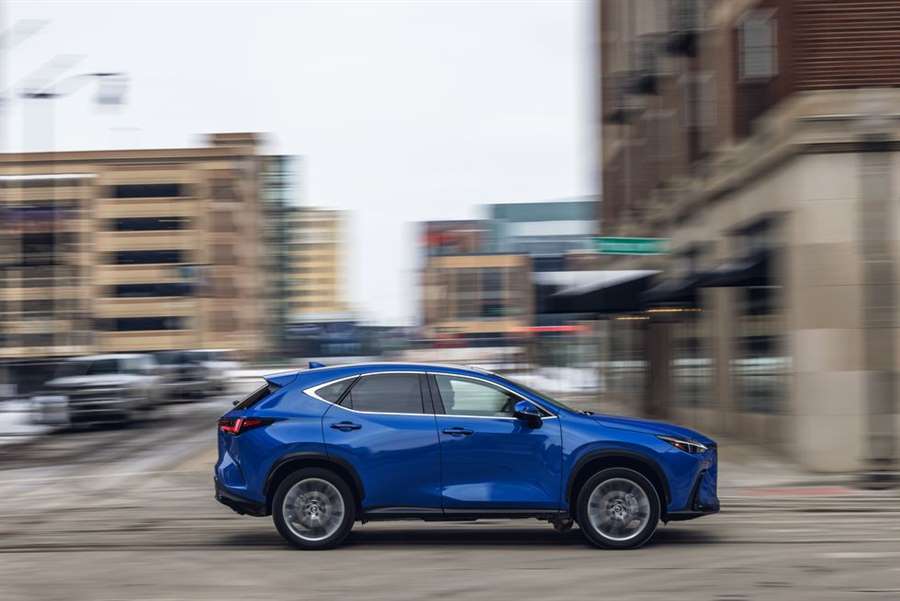
Avoid pinning the accelerator, though, and the interior of the NX350h is appropriately tranquil. Soft springs make for a cushy ride that further contributes to the sense of repose. That softness comes at the expense of body control, as the NX350h wallows through turns and nosedives under braking. Although innocuous enough in day-to-day driving, these motions underscore the fact the NX350h favors a comfortable ride over engaging responses. The nose-heavy Lexus understeers at the limit, and the optional 20-inch Bridgestone Alenza A/S 02 run-flat tires squealed shrilly as the NX350h circled our skidpad at 0.79 g—0.02 g less than its two NX siblings and its NX300h forebear.
Stomp on the left pedal at 70 mph, and the SUV comes to a halt in a class-competitive 180 feet. In non-emergency braking, though, it was difficult to smoothly bring the NX350h to a stop. Blame the pedal's unpredictable action as it switches from regenerative to mechanical braking—particularly in low-speed stops, such as at neighborhood stop signs. Instead of a seamless handoff between its two braking systems, the NX350h suddenly slows at a far greater rate once the mechanical binders take over stopping duties from the electric motors' regenerative function. That awkward modulation is a surprising misstep given that Toyota has been developing and producing hybrids for nearly a quarter of a century.
Dollars and Cents
What the NX350h lacks in grace, it makes up for by way of its low cost of entry. Only devoted plugger-inners whose daily commute is less than the plug-in's range will find a cost savings. Otherwise it will be decades before the additional $14,600 outlay for the 450+ is recouped. On our 75-mph highway fuel-economy test, the NX350h returned 34 mpg, missing the EPA's estimate by 3 mpg.
LOWS: Four-cylinder engine gets shouty at higher revs, not a sporting bone in its unibody, clumsy handoff from regenerative to mechanical braking.
Even the segment's most affordable PHEV, the Lincoln Corsair Grand Touring, is more expensive by $10,305. This does not mean consumers have no reason to choose vehicles such as the Corsair Grand Touring and NX450h+, the latter of which includes a number of dynamic enhancements over the NX350h.
However, it does mean the NX350h, as the least expensive hybrid in its segment, better meets the needs of buyers looking to purchase a hybrid compact luxury SUV as a matter of financial prudence. It may be unexciting and—in some areas—unpolished, but the 2022 Lexus NX350h is arguably a more sensible hybrid option than better-performing PHEVs.
Source: caranddriver.com
Euro 7 rules will be published tomorrow, here's what's changing
The new rules on emissions of harmful gases, whose presentation has already been delayed several times, should see the light of day on Wednesday, according to the announcement of the European Commission. It is a set of rules that will be much stricter than the Euro 6 standard, and implementation is expected after 2025.
New regulations in the form of the Euro 7 standard will limit the emission of harmful pollutants such as PM particles, hydrocarbons and carbon monoxide from petrol and diesel cars and trucks. In this way, the existing Euro 6 regulations, which have been in force since 2014, will be replaced.
Euro 7 will most likely define the pollution parameters for the last generation of internal combustion engines in Europe, because the EU plans to sell only zero-emission vehicles from 2035. Although the European Commission has announced that it will publish the new Euro 7 regulations on Wednesday, October 12, we still cannot say with certainty that this will happen.
Many manufacturers are skeptical about the new regulations, because their fulfillment requires a huge amount of money in the form of investments towards the development of SUS engines, which are going to be retired soon anyway. Certain car brands have already announced full electrification at the end of this decade, so they expressed their dissatisfaction with the timing of the introduction of new, much stricter rules on the emission of harmful gases.

















